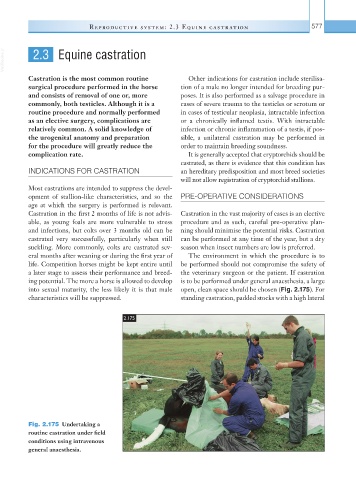Page 602 - Equine Clinical Medicine, Surgery and Reproduction, 2nd Edition
P. 602
Reproductive system: 2.3 Equine castr ation 577
VetBooks.ir 2.3 Equine castration
Castration is the most common routine Other indications for castration include sterilisa-
surgical procedure performed in the horse tion of a male no longer intended for breeding pur-
and consists of removal of one or, more poses. It is also performed as a salvage procedure in
commonly, both testicles. Although it is a cases of severe trauma to the testicles or scrotum or
routine procedure and normally performed in cases of testicular neoplasia, intractable infection
as an elective surgery, complications are or a chronically inflamed testis. With intractable
relatively common. A solid knowledge of infection or chronic inflammation of a testis, if pos-
the urogenital anatomy and preparation sible, a unilateral castration may be performed in
for the procedure will greatly reduce the order to maintain breeding soundness.
complication rate. It is generally accepted that cryptorchids should be
castrated, as there is evidence that this condition has
INDICATIONS FOR CASTRATION an hereditary predisposition and most breed societies
will not allow registration of cryptorchid stallions.
Most castrations are intended to suppress the devel-
opment of stallion-like characteristics, and so the PRE-OPERATIVE CONSIDERATIONS
age at which the surgery is performed is relevant.
Castration in the first 2 months of life is not advis- Castration in the vast majority of cases is an elective
able, as young foals are more vulnerable to stress procedure and as such, careful pre-operative plan-
and infections, but colts over 3 months old can be ning should minimise the potential risks. Castration
castrated very successfully, particularly when still can be performed at any time of the year, but a dry
suckling. More commonly, colts are castrated sev- season when insect numbers are low is preferred.
eral months after weaning or during the first year of The environment in which the procedure is to
life. Competition horses might be kept entire until be performed should not compromise the safety of
a later stage to assess their performance and breed- the veterinary surgeon or the patient. If castration
ing potential. The more a horse is allowed to develop is to be performed under general anaesthesia, a large
into sexual maturity, the less likely it is that male open, clean space should be chosen (Fig. 2.175). For
characteristics will be suppressed. standing castration, padded stocks with a high lateral
2.175
Fig. 2.175 Undertaking a
routine castration under field
conditions using intravenous
general anaesthesia.

